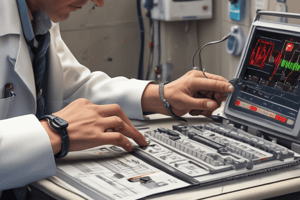Podcast
Questions and Answers
How can pain affect respiratory rate?
How can pain affect respiratory rate?
- Decreasing body temperature
- Leading to shallow or rapid breathing (correct)
- Causing an increase in heart rate
- Promoting deeper, slower breathing
Why is temperature essential in detecting and monitoring infections?
Why is temperature essential in detecting and monitoring infections?
- To detect temperature changes related to infections (correct)
- To assess blood pressure changes
- To understand respiratory rate
- To measure pain intensity
Which pain scale is specifically designed for assessing pain in advanced dementia?
Which pain scale is specifically designed for assessing pain in advanced dementia?
- Numeric Rating Scale (NRS)
- Pain Assessment in Advanced Dementia (PAINAD) scale (correct)
- Visual Analog Scale (VAS)
- Body Mass Index (BMI)
What did a study by the Portuguese Ministry of Health find regarding the recording of pain as a vital sign?
What did a study by the Portuguese Ministry of Health find regarding the recording of pain as a vital sign?
Why is it challenging to objectively measure pain according to the text?
Why is it challenging to objectively measure pain according to the text?
How can pain relief influence breathing patterns?
How can pain relief influence breathing patterns?
How did the American Pain Society aim to highlight the importance of pain in patient care?
How did the American Pain Society aim to highlight the importance of pain in patient care?
What can elevated blood pressure indicate in relation to pain?
What can elevated blood pressure indicate in relation to pain?
How can pain affect heart rate in patients?
How can pain affect heart rate in patients?
Which vital sign can provide information about a patient's respiratory function?
Which vital sign can provide information about a patient's respiratory function?
In what way can pain contribute to increased blood pressure?
In what way can pain contribute to increased blood pressure?
Why is temperature not directly discussed as a potential indicator of pain in the text?
Why is temperature not directly discussed as a potential indicator of pain in the text?
Flashcards are hidden until you start studying
Study Notes
Vital Signs and Pain Assessment
Introduction
Vital signs, including blood pressure, heart rate, respiratory rate, and temperature, are essential indicators of a patient's health status. However, pain, a prevalent and complex symptom, has long been a critical yet often overlooked aspect in the assessment of a patient's condition. Recognizing the importance of pain in overall patient care, the American Pain Society launched the "pain as the 5th vital sign" campaign in 1996, which has since influenced many countries to incorporate pain assessment into their routine procedures.
Blood Pressure
Blood pressure is a crucial vital sign that indicates the force of blood against the blood vessel walls. While pain is not directly correlated with blood pressure, elevated blood pressure can be a sign of pain or discomfort in certain conditions, such as headaches or chest pain. Pain can also contribute to increased blood pressure through the release of stress hormones.
Heart Rate
Heart rate, measured in beats per minute, is another vital sign that can provide information about a patient's cardiovascular health. Pain can affect heart rate, as it can cause increased sympathetic nervous system activity, leading to an increase in heart rate. Conversely, pain relief can lower heart rate.
Respiratory Rate
Respiratory rate, measured in breaths per minute, is an indicator of a patient's respiratory function. Pain can affect respiratory rate, as pain can lead to shallow or rapid breathing, while pain relief can promote deeper, slower breathing.
Temperature
Temperature, measured in degrees Celsius or Fahrenheit, is essential in detecting and monitoring infections and other physiological processes. Temperature changes can be a sign of pain or discomfort, as pain can cause an increase or decrease in body temperature.
Pain Scale Assessment
Pain is subjective and can vary greatly between individuals, making it challenging to measure objectively. Various pain scales have been developed to assess and quantify pain, such as the Numeric Rating Scale (NRS), the Visual Analog Scale (VAS), and the Pain Assessment in Advanced Dementia (PAINAD) scale. These scales help healthcare providers to understand a patient's experience and manage pain more effectively.
Vital Signs and Pain Assessment
Despite the importance of pain assessment, a study by the Portuguese Ministry of Health found that not all hospitals consistently record pain as a vital sign. Public hospitals demonstrated better commitment to these procedures, with a higher adherence to the process related to the pain intensity assessment, better quality of pain records in the hospital charts, and more regular audits. Nurses also have varying opinions on the evaluation of pain as a fifth vital sign. Some believe that pain should be considered as part of overall patient care, while others see it as a subjective experience that may not be consistently reported or may be overlooked due to workload and staffing constraints.
Conclusion
Effective pain assessment is crucial for appropriate pain management and overall patient care. While blood pressure, heart rate, respiratory rate, and temperature are vital signs that provide essential information about a patient's health status, pain should not be overlooked. By incorporating pain assessment into routine procedures, healthcare providers can better understand and address their patients' pain, leading to improved patient care and outcomes.
Studying That Suits You
Use AI to generate personalized quizzes and flashcards to suit your learning preferences.




